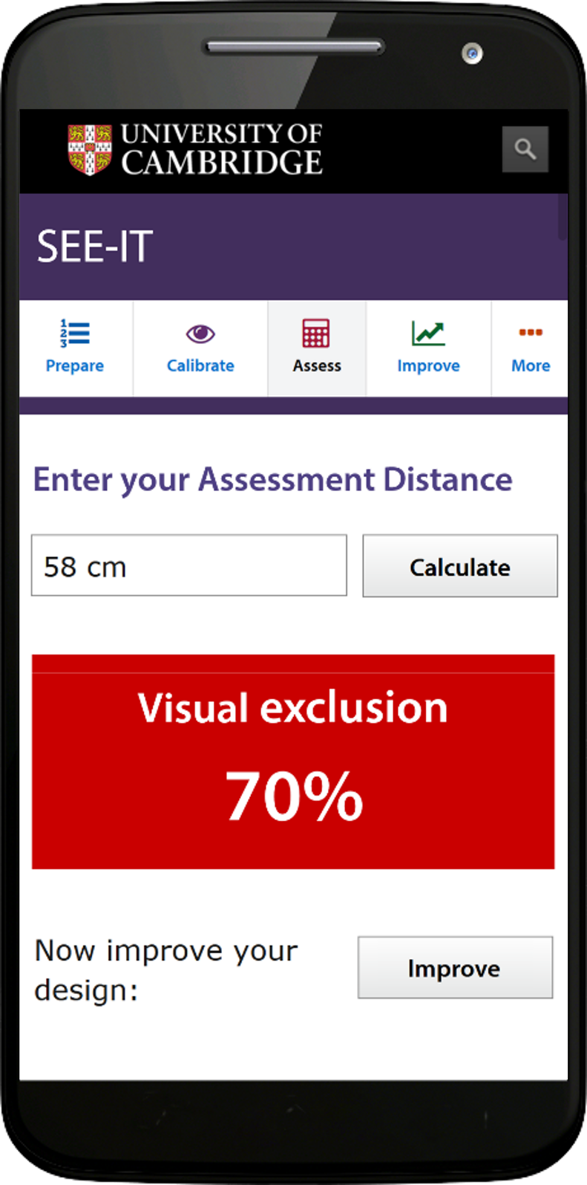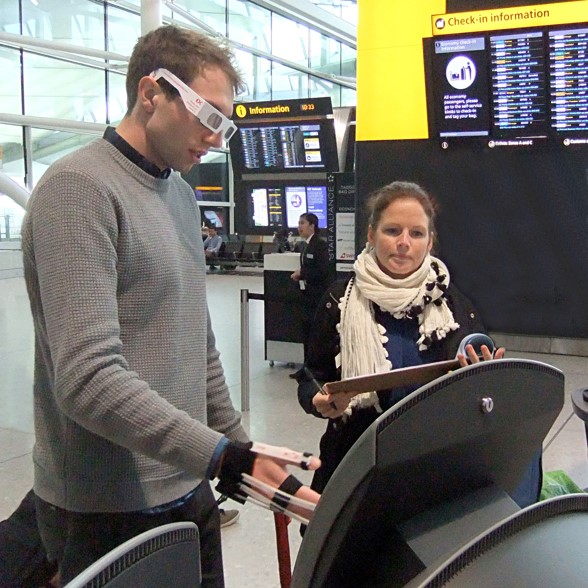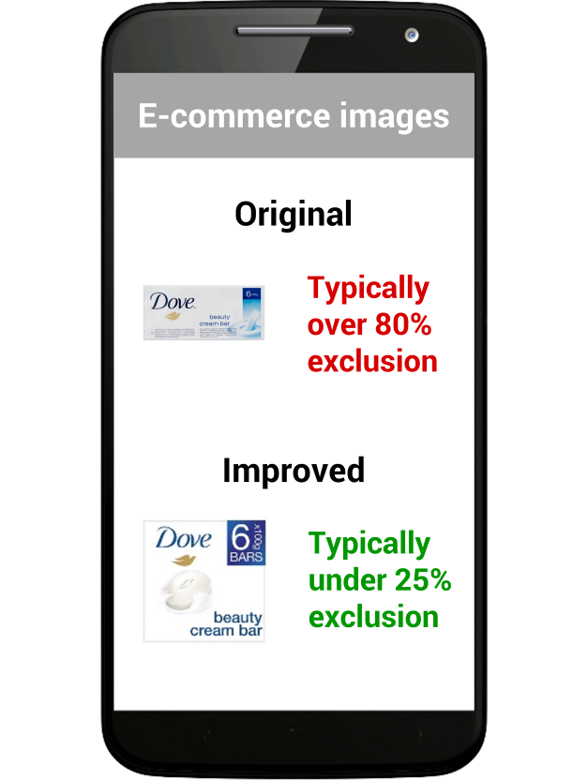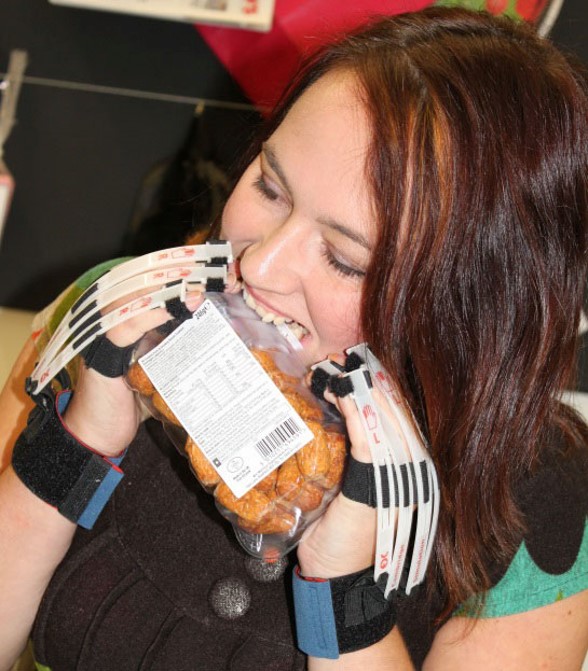Welcome to the first edition of the inclusive design toolkit news bulletin, produced by the Cambridge Engineering Design Centre. This bulletin showcases people’s achievements with this website, and highlights new tools and ways of using them. In this issue, we announce the launch of our new SEE-IT Tool for calculating visual exclusion, and report on the outcomes of our work with Unilever and Barclays.
If you would like to receive this bulletin on a regular basis, or contribute to it, then please fill in the feedback form at the bottom of this page.
On this page:
- Cambridge develops new SEE-IT Tool for calculating visual exclusion
- Inclusive Design Consortium members audit the passenger experience at Heathrow
- Cambridge helps Unilever optimise their product images for e-commerce
- Barclays uses simulation tools to help them become the most inclusive bank
- Sheffield Hallam University tests open-ability of food packaging
- Include 2015 uses simulation gloves in 3D prototyping workshop
This news bulletin is produced by the Cambridge Engineering Design Centre.
Cambridge develops new SEE-IT Tool for assessing visual exclusion
SEE-IT stands for Sight Exclusion Estimator - Interactive Tool. This mobile-friendly website enables you to assess the visual clarity of text or graphics that are handheld. It estimates the number of people who would be unable to see such designs comfortably. It can help to identify design improvements, and can estimate how many customers would benefit from the changes.
The beta version of SEE-IT has just been launched by the Inclusive Design Toolkit team. It is freely available at seeit.inclusivedesigntoolkit.com/. We are keen for people to try it out and give us feedback on how they use it and how it could be improved.
The SEE-IT tool is freely available from seeit.inclusivedesigntoolkit.com.
Inclusive Design Consortium members audit the passenger experience at Heathrow
In November 2015, participants from the Centre for Business Innovation, Inclusive Design Consortium used the Cambridge Simulation Gloves and Glasses to audit the end-to-end passenger experience at London Heathrow Airport’s new Terminal 2.
Participants found that the EDC glasses and gloves enabled them to get inside the minds and bodies of older people and experience the environment in a way that wouldn’t have been possible otherwise. They gained an understanding of the tasks that could potentially be really challenging for those with poor eyesight and limited movement in their hands.
They also had to deal with baggage and mobility aids (including a walking stick) and these highlighted difficulties when both hands are needed for certain tasks. They looked at the impact of co-occurrence of impairments to sight, hearing, thinking, reach & stretch, dexterity and mobility on key tasks such as check-in, baggage drop and navigating from arrivals to their ongoing surface transport. This led to insights which could be missed by typical Access Audits, which often do not include an assessment of the demands placed on all these human capabilities at the same time.
Cambridge helps Unilever optimise their product images for e-commerce
The University of Cambridge, Engineering Design Centre helped Unilever to optimise their product images for e-commerce, especially on mobiles.
The SEE-IT tool was used to identify opportunities to improve the visual clarity of these images, which informed the decisions made in their early-stage development. Dove e-commerce images were among the first to be improved, as shown opposite.
“
This assessment worked extremely well to communicate how usable our images were, as the percentage exclusion is easy to explain and understand. ”
This work lead to the development of recommendations for the design of e-commerce images in general to make them visually clearer and more suitable for use on mobile devices. These recommendations and templates for developing such images are available on our E-commerce image recommendations page.
During 2016, the majority of Unilever’s UK brands launched improved e-commerce images within Asda, Sainsburys, Tesco and Superdrug. In total, thousands of ‘mobile-first’ images have launched in the UK, USA and 13+ other markets. This case study demonstrates how the SEE-IT tool was agile enough to inform design decisions in real time and justify the improvements commercially. The subsequent sales feedback suggests the shopping experience has been improved for millions of people.
You can follow on this story on @eCommerceULVR.
Barclays uses simulation tools to help them become the most inclusive bank
Fiona Morden worked with her client Barclays to improve accessibility for their customers and colleagues. Key to engaging colleagues with the benefits of inclusive design was the use of simulation equipment, such as the Cambridge Simulation Gloves. These helped to build a deeper understanding of the end-user experience.
“
At Barclays we have set out our ambition to become the most inclusive and accessible bank. Simulation equipment helps us translate our inclusive design principles into practical ideas to create an accessible workplace and service environment. ”
Using the gloves enriched the flow of practical, simple and low-cost ideas to improve products and services as well as the workplace. A rubber grip was added to the giveaway pens used in UK branches, to improve ease of use for customers with reduced dexterity.
Fiona Morden is Director of Morden Solutions (UK) Ltd, who specialise in Diversity, Inclusion and Accessibility. Contact: fiona@mordensolutions.com.
Sheffield Hallam University tests open-ability of food packaging
Sheffield Hallam University conducted a study into the ‘openability’ experience of packaging with resealable peelable labels. A group of older participants (without any simulators) and a group of younger participants (using the Cambridge Simulation Gloves) took part.
The gloves enabled the younger cohort to experience similar problems to the older cohort, including needing to use their teeth to successfully access the pack. Contact: Alaster Yoxall (A.Yoxall@shu.ac.uk).
Include 2015 uses simulation gloves in 3D prototyping workshop
At the Include 2015 conference, a Masterclass led by Dr Eujin Pei and Dr Chris Lim enabled participants to appreciate the use of 3D printing for prototyping. As part of this practical activity, the Cambridge Simulation Gloves provided fantastic insight into the difficulties people have in gripping and holding hot drinks cups, and were instrumental in developing a more inclusive solution.
Feedback
We would welcome your feedback on this page:
Privacy policy. If your feedback comments warrant follow-up communication, we will send you an email using the details you have provided. Feedback comments are anonymized and then stored on our file server. If you select the option to receive or contribute to the news bulletin, we will store your name and email address on our file server for the purposes of managing your subscription. You can unsubscribe and have your details deleted at any time, by using our Unsubscribe form. If you select the option to receive an activation code, we will store your name and email address on our fileserver indefinitely. This information will only be used to contact you for the specific purpose that you have indicated; it will not be shared. We use this personal information with your consent, which you can withdraw at any time.
Read more about how we use your personal data. Any e-mails that are sent or received are stored on our mail server for up to 24 months.









